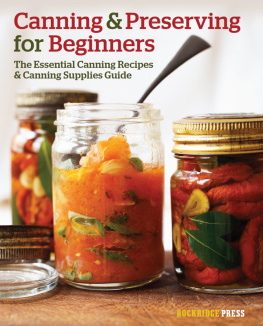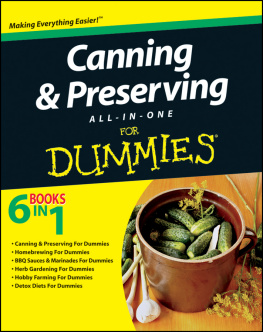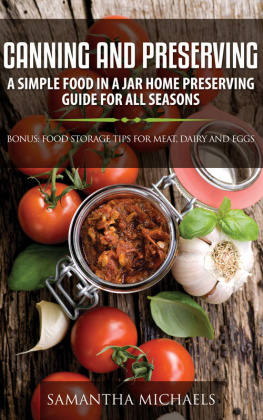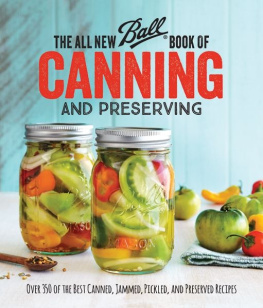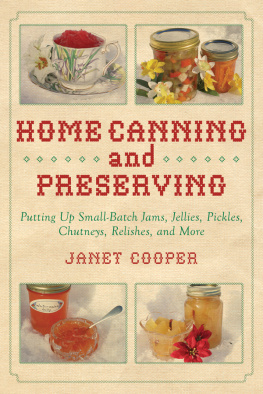THIS IS A BORZOI BOOK
PUBLISHED BY ALFRED A. KNOPF
Copyright 2013 by Kevin West
All rights reserved. Published in the United States by Alfred A. Knopf, a division of Random House, Inc., New York, and in Canada by Random House of Canada Limited, Toronto.
www.aaknopf.com
Knopf, Borzoi Books, and the colophon are registered trademarks of Random House, Inc.
All photographs are by the author with the exception of the following: , from The Plant Kingdoms of Charles Jones by Sean Sexton and Robert Flynn Johnson. Reprinted by permission of Thames & Hudson, Ltd., London.
The painting on is titled Blackberries by Raphaelle Peale. Reprinted courtesy of the Fine Arts Museums of San Francisco. Gift of Mr. and Mrs. John D. Rockefeller III.
Additional acknowledgments for permission to reprint previously published material may be found .
LIBRARY OF CONGRESS CATALOGING-IN-PUBLICATION DATA
West, Kevin, 1970
Saving the season : a cooks guide to home canning, pickling, and preserving / by Kevin West.First edition.
pages | | cm
Includes bibliographical references and index.
eBook ISBN: 978-0-307-95768-9
Hardcover ISBN: 978-0-307-59948-3
1. Canning and preserving. | I. Title.
TX 601. W 47 2013
641.42dc23
2012037844
Cover photographs Kevin West
Cover design by Carol Devine Carson
Illustrations Nicola Atkinson
v3.1
FOR GRAN AND PAPA
MARY ELOISE WEST
[ 19161981 ]
JOHN R. WEST
[ 19121999 ]
O greatly fortunate farmers, if only they knew
How lucky they are! Far from the battlefield,
Earth brings forth from herself in ample justice
The simple means of life, simply enjoyed.
V IRGIL S SECOND GEORGIC,
TRANSLATED BY DAVID FERRY
CONTENTS
PREFACE
T HIS IS A BOOK ABOUT PRESERVING and home canningor putting up, as one might say where Im fromand it will cover jam, jelly, marmalade and other sweet preserves; pickles and briny things; canned tomatoes; liqueurs; candies; and the complement of condiments that includes relishes, sauces, and salsas.
Why bother preserving? So that you can eat your efforts later, of course, and give them to other people to eat, too.
I do it to save the season.
Putting up used to be how plenty prepared for want. Foodstuffs were processed in a season of abundancewhen the wild blackberries came in, when hogs were slaughtered at the first cold snapand brought out to eat in some later time of scarcity.
Today we dont suffer the winter hunger known for most of human history, because the grocery store is always stocked. Not that long ago, though, it was the agricultural cyclenaturethat determined what was on the table, and lusty eaters had to anticipate the harvest of each month, when gardens, orchards, fields, woods, rivers, oceans, and skies delivered a copious annual bounty of a particular thing at a particular time. Weve forgotten today to wait for seasonal delicacies, and as a punishment the grocery store has become a year-round warehouse of indifferent fruit and vegetable staples, some of which are absurdly imported from the ends of the earth.
Just a generation agothat is to say, when I was littlestrawberries were a cause for celebration in the spring. My mother and I made annual trips to a pick-your-own farm, where we were always amazed by how good the strawberries were and by how quickly we could pick more than we could eat. In August we visited my West grandparents, Gran and Papa, and when we returned to South Carolina from their farm in Blount County, Tennessee, my mothers baby-blue VW Bug would be loaded literally to the roof with bags of corn, buckets of okra and squash, watermelons, and flats of Papas homegrown tomatoes.
Theres only two things that money cant buy, Papa would say. Thats true, true love and homegrown tomatoes.
When Gran put them up in quart Mason jars, Papas tomatoes were as good in January as they had been in August.
Thats what I mean by saving the season.
INTRODUCTION
Its not without reason that weve learned to watch
The rising and the setting of the stars,
Marking the equal seasons as they change.
V IRGIL S FIRST GEORGIC
I wrote Saving the Season while living in the Hollywood Hills, in a house that I called Greenvalley, near the top of a shaded canyon. Greenvalley appears in the corners of my photographs and between the lines of my stories because it was the house where I first made jam, the home where my canning hobby became an obsession, and the kitchen I returned to after shopping at farmers markets and visiting farmers in California and around the country. Because Greenvalley was the center of my life for seven years, it was naturally the center of my canning life as well. I cant write about preserving without also writing about Greenvalley, the place where those preserves were made and where they were eaten, often in lively company.
My book is called Saving the Season because I found myself frustrated that the foods I most loved eatingasparagus, apricots, raspberries, mulberries, peaches, tomatoes, quince, Seville orangeswould appear at the local farmers markets in profusion one week, only to disappear quicker than I would have wished the next. Natures bounty is abundant but fleeting. I wanted to save the season, and preserving is my way to do it.
I find it odd when people insist that there are no seasons where I live in Southern California. Its not true: we have six. The principal annual division is between the wet seasonroughly Halloween to Easter, when it feasibly could rainand an extended drought throughout the rest of the year. Specialists call this two-season weather pattern a Mediterranean climate, and it puzzled me, a Southerner, when I first moved to California in 2004. The wild canyons around Greenvalley spring to life, curiously, in fall, after the first rain. Winter is the lush season, summer the dormant phase.
Overlaying this cycle are the four seasons you learned about in elementary school. The shift between spring, summer, fall, and winter is less dramatic here than elsewhere, but it is distinct nonetheless, especially at the well-supplied farmers markets around the city. In March, Bill and Barbara Spencer of Windrose Farm in Paso Robles bring baskets of newly sprouted greens and buckets of flowering apple branches to the Santa Monica Farmers Market. James Birch of Flora Bella Farm arrives with wild nettles harvested from the Sierra foothills. Asparagus, pea tendrils, radishes, tiny carrots, and strawberries soon follow; then, one bright day in April, the temperature will briefly hit eighty degrees and all vegetative life seems to leap up. Everything is sweet: the smell of flowers, the taste of new food, the douceur of sunshine, and the pangs of our inescapable animal desires to feed and mingle. Spring!


